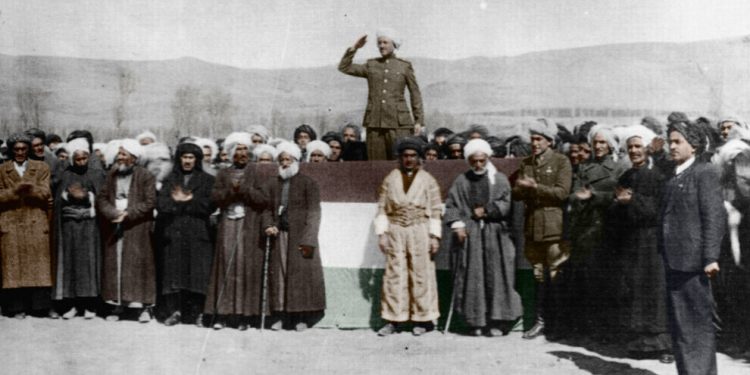NEWS CENTER – 77 years have passed since the establishment of the Republic of Kurdistan, which was announced on January 22, 1946, in the historical square of Charçira in Mehabad. The republic that lasted for 11 months was established thanks to historical opportunities.
The second year of World War 2; In 1941, Russian troops attacked Iran from the east and the British from the south. During the British occupation, on September 2, 1941, the Turkish government sent a message to London. The message drew attention to Kurdish organizations in the region and warned the British government. During those days, a delegation of Kurds led by Qazi Muhammad went to Baku and met with the Soviet Union. The Kurdish delegation that met with the Prime Minister of Azerbaijan Bakirov signed many agreements with the Soviet administration, especially in the economic field.
At that time, the Kurds returned to their lands with the promise of Soviet support, and on August 16, 1943, the Association (Kurdistan Revival Society) was established. In 1944, three Kurdish organizations Komele, Khoybun and Hêv came together, decided to merge and signed an agreement called ‘Three Borders’. The process towards Mehabad was achieved thanks to the unity of the Kurds and the opportunities achieved by the balance in the region.
IN THE FRAMEWORK OF THE HISTORICAL DAY
He was elected on January 22, 1946. On that day, in the historical square of Mehabad, in front of thousands of people who gathered in the historical square of Mehabad, Qazi Muhammed declared the republic with these words: I swear with my last blood and my last breath that I will defend the independence and the republic of Kurdistan.”
The election of 46-year-old Qazi Muhammed as the president was not a coincidence.
Qazi Muhammed, who was seen as the president of the preparation committee of the republic, came from a family with religious roots in the region. His uncle, Fatah Qazi, lost his life in the war against Russia in 1916, and his grandfather, Sheikh Elmeshayekh, proposed the creation of a “common front” against the British in 1930 by gathering the Kurdish tribes in the city of Diwandar.
THE KURDISH COLORS ARE ON THE FLAG OF THE REPUBLIC FOR THE FIRST TIME
A few days after the announcement, the government cabinet consisting of 14 ministers was formed. The colors of the symbol of Kurdish unity were shown for the first time on the flag of a republic, and the poem of the Kurdish poet Dildar called “Ey Reqîp”, which he wrote in 1938 while he was in prison, was accepted as the national anthem. In the first republic, there was only one printing press where the founding declarations were printed.
When Kurdish education started in the regional schools within the borders of the republic, the militias were transferred to the regular army. In the early days, the army had only 10,000 rifles and 20 ammunition trucks. Another important work of the Republic was in the field of culture, art and literature. By the decision of the republic, operas were established in a short period of time and many media-publishing works were done, from scientific books to children’s magazines.
CHANGING HARMONIES IN THE WORLD AFTER WORLD WAR 2
On the one hand, these historical developments are happening for the Kurdish people of Mehabad in Eastern Kurdistan, on the other hand, in those days when World War 2 ended, new orders and balances were being established in the world. In the Western world, which was led by the USA, the place of fear of Hitler’s Germany has changed with the cold war between the East and the West. The Soviet Union was approaching Iran.
The Moscow administration decided to immediately withdraw its forces from the region after concluding oil agreements with Tehran. Here, the Kurdistan Republic was left without support, and the achievements were sacrificed to the talks on the table. The Red Army withdrew from Iran on May 9, 1946, and the Iranian army, which entered Mehabad on December 17, arrested the leaders of the republic. The head of the General Staff, Mullah Mustafa Barzani, after a long march with his 500 peshmerga, took refuge in the Soviet Union by crossing the Aras River.
EXECUTION AREAS HAVE BEEN ESTABLISHED
On January 23, 1947, exactly one year and a day after the establishment of the republic, the military court of Iran sentenced Qazi Muhammad to death. On March 31 of the same year, the square where the republic was declared; Qazi and his 2 companions were hanged in Çarçira. 47-year-old Qazi Muhamed entered history as the last Kurdish leader to be hanged in the 20th century.




